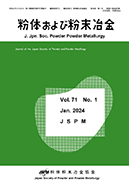
- |<
- <
- 1
- >
- >|
-
Motomu SAKAI2024Volume 71Issue 5 Pages 143-148
Published: May 15, 2024
Released on J-STAGE: May 10, 2024
Advance online publication: January 06, 2024JOURNAL OPEN ACCESSZeolites have been used as a separation membrane material by taking advantages of their unique adsorption properties and molecular sieving properties based on the micropores. Zeolite membranes are widely used in practical applications, mainly for dehydration of organic solvents. Furthermore, the research and development continue toward large-scale implementation in the energy and carbon neutral field. The high heat and chemical resistance of zeolite membranes are also expected to be utilized as membrane reactors. Zeolite membrane and membrane separation will contribute to the fulfillment of a carbon-neutral society through energy saving in separation, reaction, and CO2 recovery. In this review, the basic structure, the synthesis methods and the applications of zeolite membranes are introduced. The recent research trends of zeolite membrane in the research and applications are also explained.
View full abstractDownload PDF (2153K)
-
Takamasa ISHIGAKI, Satoshi KOYASU2024Volume 71Issue 5 Pages 149-153
Published: May 15, 2024
Released on J-STAGE: May 10, 2024
Advance online publication: January 25, 2024JOURNAL OPEN ACCESSFabrication of ceramic materials has been developed through building up block particles. One of the commonest process of building blocks is a sintering process, in which dense sintered bodies are fabricated via building up particles. This work shows a different type of building blocks. Oriented ZnO seed layers composed of hexagonal plate-like ZnO particles were prepared by dip-coating convective self-assembly method through adjusting the particle volume fraction in suspension and the substrate withdrawal rate. Oriented ZnO rod films were fabricated by growing seed layers using a hydrothermal method. Concentration of the precursor, and hydrothermal treatment time was optimized to synthesize homogeneous ZnO rod arrays. The uniformity of the rod arrays was improved by applying a strong magnetic field (12 T) during hydrothermal treatment.
View full abstractDownload PDF (2732K) -
Takaaki TANIGUCHI, Kazuto HATAKEYAMA, Shintaro IDA2024Volume 71Issue 5 Pages 154-160
Published: May 15, 2024
Released on J-STAGE: May 10, 2024
Advance online publication: December 27, 2023JOURNAL OPEN ACCESSTwo-dimensional nanomaterials have been studied as materials that may exhibit properties and functions different from those of bulk materials. In this review, graphene oxide with controlled surface oxygen functional groups, transition meta dichalcogenide (hereafter referred to as TMDC), MXene nanosheets and oxynitride nanosheets using soft chemical exfoliation synthesis, and their typical functions are described.
View full abstractDownload PDF (2583K) -
George HASEGAWA2024Volume 71Issue 5 Pages 161-166
Published: May 15, 2024
Released on J-STAGE: May 10, 2024
Advance online publication: September 30, 2023JOURNAL OPEN ACCESSA new synthetic strategy to produce porous ceramic particles with well-defined polyhedral particle morphology and three-dimensionally interconnected mesoporous structure has been developed by means of the combination of topotactic conversion of polyhedral crystal precursors and pyrolysis-induced phase separation. The crystal morphology of precursors is controlled by the liquid-phase synthesis, while the mesoporous structure in each polyhedral particle is tailored by the selective removal of a phase-separated phase preserving the other phase. In this review, two examples of porous polyhedral metal oxides prepared from hydrogarnet precursors: mesoporous and mesocrystalline 12CaO • 7Al2O3 mayenite microcubes and porous SrFeO3-δ perovskite polyhedral particles. The synthesis and characterization of these porous materials as well as their applications in catalysis are overviewed.
View full abstractDownload PDF (1938K) -
Yoshifumi KONDO, Tomoyo GOTO, Tohru SEKINO2024Volume 71Issue 5 Pages 167-174
Published: May 15, 2024
Released on J-STAGE: May 10, 2024
Advance online publication: January 12, 2024JOURNAL OPEN ACCESSTitanates are one of promising sorbents for toxic heavy metal ions and radionuclides due to various chemical formulas and crystal structures, and their functional properties. Herein, we present a unique seaweed-like sodium titanate mat (SST) with randomly distributed layered sodium dititanate nanofibers synthesized by a simple hydrothermal process. We focused on the effect of NaOH concentration during the hydrothermal process on crystallographic properties and investigated the synthesis conditions for SST. Furthermore, Sr2+ sorption properties of SST and related titanates, which were synthesized by hydrothermal process, was studied by batch tests. SST, which consist of a dititanate phase, was synthesized at 10 mol/L NaOH concentration and trititanate phase was formed when the NaOH concentration was increased to 15 mol/L. The SST showed a high ion-exchange selectivity of Sr2+ against H+ and a high maximum sorption capacity (2 mmol/g), compared with the case of trititanate phase (0.49 mmol/g), which shows the precipitation of SrCO3. This was presumably due to the difference of crystal structure of two titanates. This study demonstrates that the design of the crystal structure is important for controlling the sorption mechanism of sorbents for water treatment.
View full abstractDownload PDF (4746K)
-
2024Volume 71Issue 5 Pages Pref5_1
Published: May 15, 2024
Released on J-STAGE: May 10, 2024
JOURNAL OPEN ACCESSDownload PDF (574K) -
2024Volume 71Issue 5 Pages Mtg5_2-Mtg5_10
Published: May 15, 2024
Released on J-STAGE: May 10, 2024
JOURNAL OPEN ACCESSDownload PDF (1033K) -
2024Volume 71Issue 5 Pages Pref5_12
Published: May 15, 2024
Released on J-STAGE: May 10, 2024
JOURNAL OPEN ACCESSDownload PDF (517K) -
2024Volume 71Issue 5 Pages MtgPr5_1-MtgPr5_25
Published: May 15, 2024
Released on J-STAGE: May 10, 2024
JOURNAL OPEN ACCESSDownload PDF (1616K)
- |<
- <
- 1
- >
- >|